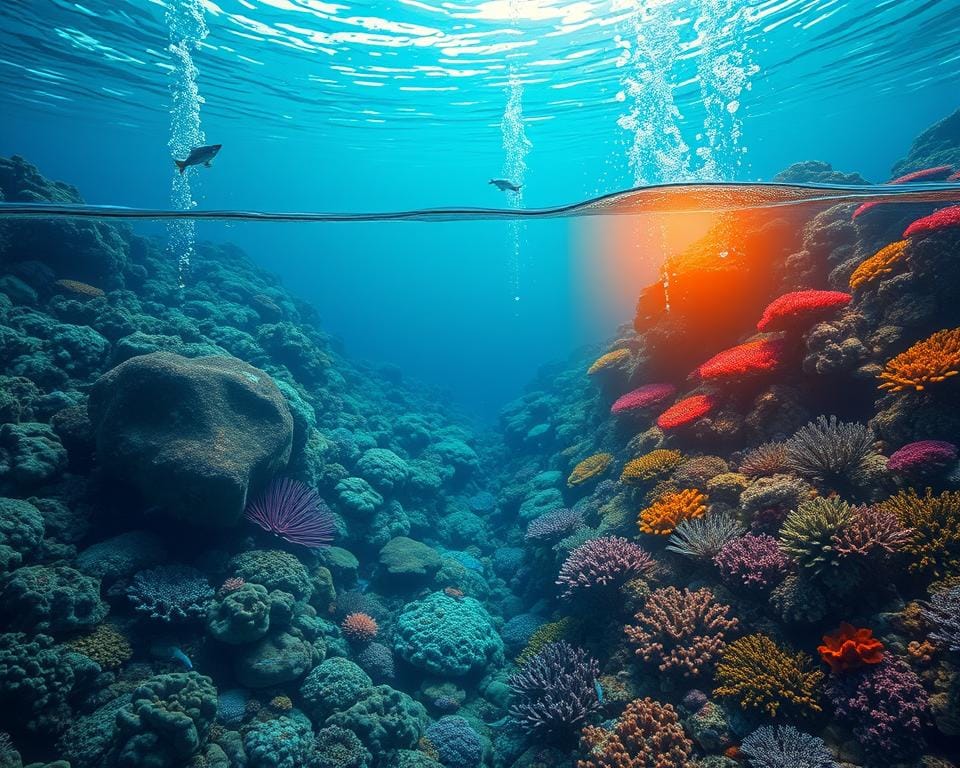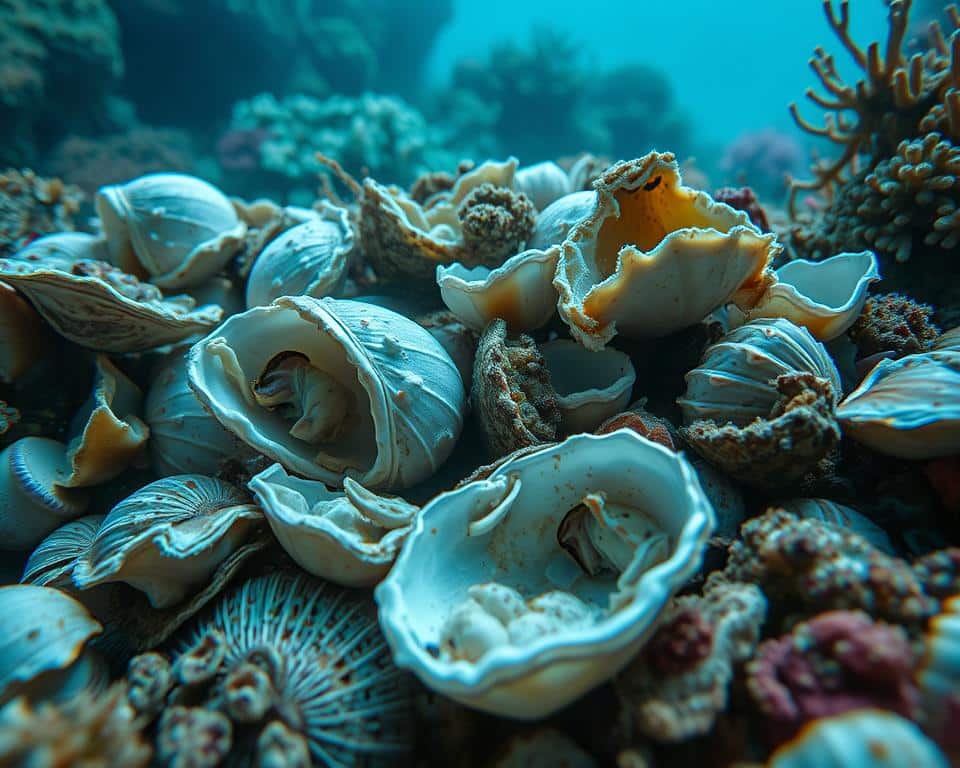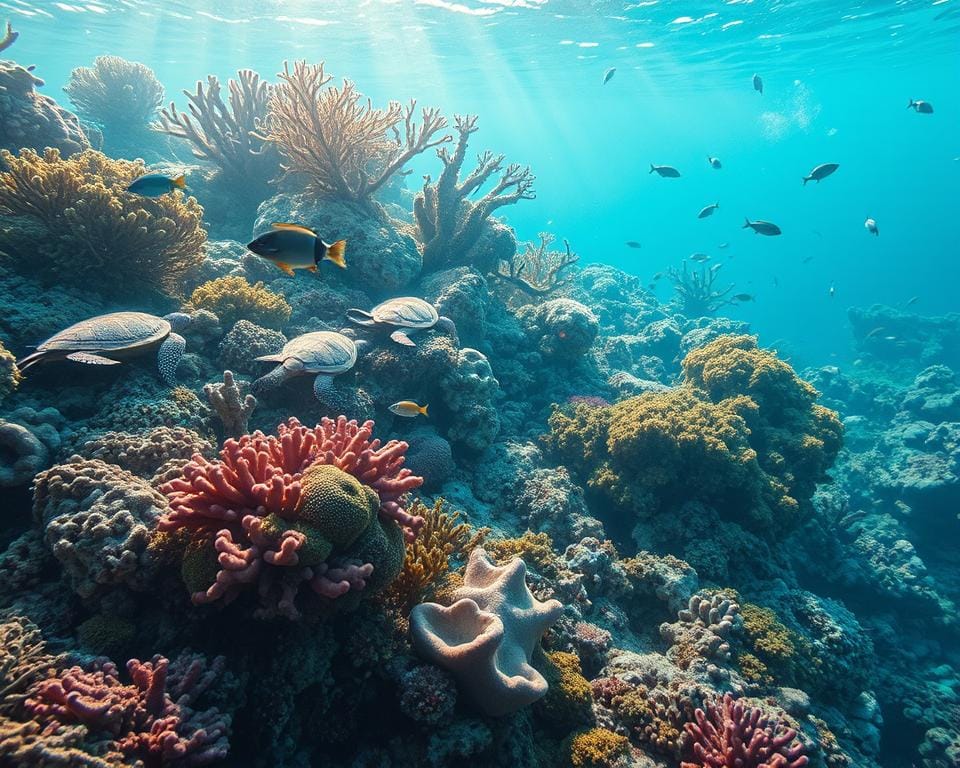Ocean acidification poses big challenges to our marine ecosystems. The effects touch everything from biodiversity to the balance of life underwater. This issue starts from carbon dioxide emissions, mainly from burning fossil fuels and cutting down forests. Check the detailed impact of ocean acidity.
About 30 percent of carbon from the air ends up in the sea. There, it leads to more acidic water. This problem affects areas from the Pacific Northwest to coral reefs in the Caribbean. It harms marine life, their homes, and the food chains they are part of.
For example, some oyster hatcheries have lost 80% of their production. This disruption threatens not just shellfish and coral reefs, but also whales, seals, and seabirds. Additionally, over half a billion people depend on coral reefs for food or money from tourism.
Local acidification hotspots are growing due to coastal erosion and more fertilizer runoff. It’s crucial for big observational programs, like NOAA’s PMEL Carbon Program, to keep track of the damage. This issue, together with ocean warming, creates a big challenge for our world, especially in temperate and tropical regions.
To protect our oceans from climate change, we need to target the causes of acidification. Then, we must find sustainable ways to lessen its impact.
Understanding Ocean Acidification
Ocean acidification is a growing environmental problem, changing our oceans deeply. It’s one of the key ways CO2 affects seawater. Through complex reactions, it makes the ocean more acidic.
The Chemistry of Ocean Acidification
The process starts when the ocean absorbs CO2 from the air. This CO2 turns into carbonic acid in the water. The carbonic acid then breaks down, increasing ocean acidity. This makes the water more acidic, hurting many marine lives, according to the 2021 IPCC glossary.

Changes in Ocean pH Levels
Long ago, ocean water pH was around 8.2. Now, it’s about 8.1 due to CO2. This slight change marks a 26% increase in acidity since the Industrial Revolution. If we don’t act, the situation will get worse, shows research from 2020 by Lovenduski et al.
The 2023 Global Carbon Budget report tells us that emissions from fossil fuels and land use changes add 40 billion tons of CO2 yearly. This CO2 makes the ocean acidic, putting marine life at risk. Areas like the polar seas are getting acidic very fast, says the Copernicus Marine Service.
In places like Long Island Sound, the effects are even clearer. The seawater pH has dropped faster than the global average since 1985. This fast change threatens the local marine life greatly. It shows how critical it is for us to find solutions quickly.
Impact on Marine Life
Ocean acidification is a big problem for marine life. The shellfish vulnerability to acidity is a major concern. It puts at risk important species like lobsters and scallops. In New Hampshire, the lobster industry is crucial. It adds around $132 million to the economy every year. Lobster catches make up nearly 70% of the state’s commercial fisheries.
Effects on Shellfish and Coral Reefs
Shellfish and coral reefs don’t do well with changes in the ocean’s chemistry. Since the Industrial Revolution, the ocean has become 30% more acidic. This harms marine life that needs calcium carbonate for their shells and skeletons.

For shellfish, lower pH levels can weaken their shells. This makes them easier targets for predators and more sensitive to stress. The ocean’s natural buffering is too slow to help. It can’t keep up with the fast increase in carbon dioxide.
Coral reefs face the same dangers. More acidic oceans can damage them. This makes them weak against storms and slows down their recovery. The breaking down of coral skeletons hurts the whole marine ecosystem.
Influence on Marine Food Webs
The problem of ocean acidification touches the entire marine food web. Small sea life with calcium carbonate structures, like some plankton, are in danger too. In a few decades, the ocean might harm these creatures. This could be bad news for the bigger fish and mammals that eat them.
The Arctic Ocean is in trouble because its cold waters absorb carbon dioxide faster. This affects important small marine life. Bigger fish and mammals that eat these small creatures could run out of food. This would upset the balance in the ecosystem.
The decline of key species like plankton and coral affects everything in marine ecosystems. For example, the American lobster, which brought in over $32.5 million in New Hampshire in 2022, is under threat.
Let’s examine the effect of more acidic oceans on important marine life and economic areas:
| Marine Species or Sector | Impact of Increased Acidity | Economic Contribution |
|---|---|---|
| Lobster (New Hampshire) | Weaker shells, increased mortality rates | $132 million per year |
| Coral Reefs | Decreased resilience, slower recovery rates | Critical for tourism and coastal protection |
| Plankton Species | Corrosive ocean environments, population decline | Foundation of marine food webs |
| American Lobster (New Hampshire) | Vulnerability to acidity, shell weakness | $32.5 million in 2022 |
Regional Vulnerabilities to Ocean Acidification
The ocean is absorbing more carbon dioxide, making it 26% more acidic. This change affects many regions worldwide, including areas in the United States.
Hot Spots in the United States
The Pacific Northwest and the Chesapeake Bay are major areas affected by ocean acidification in the U.S. The shellfish industry, worth over $1 billion, is at risk. Oysters and other shellfish can’t form shells properly due to the acidic water.
In Alaska, the fishing industry faces big problems. The drop in ocean pH is bad for shelled animals. This affects the whole marine food chain and hurts the jobs it supports.
The U.S. federal government is working hard to fight ocean acidification. Since 2022, California’s monitoring network has received funding for science projects on ocean acidification.
Global Threats to Ecosystems
Ocean acidification threatens marine ecosystems worldwide. For example, coral reefs in the Caribbean are getting weaker. This damage hurts the fish that live there and affects the whole ecosystem. In Australia, the Great Barrier Reef is also suffering, losing coral because of the changing sea chemistry.
Acidic waters in Antarctica endanger shelled animals. In Patagonia, the sustainability of local fisheries is at risk. Around the world, scientists and policymakers are joining forces. They aim to protect the ocean from acidification and keep marine life safe.
| Region | Issue | Economic Impact |
|---|---|---|
| Pacific Northwest, U.S. | Hot spots of ocean acidification | U.S. shellfish industry at risk valued at over $1 billion |
| Chesapeake Bay, U.S. | U.S. shellfish industry at risk | Impact on oyster farming and related jobs |
| The Caribbean | Weakening coral structures | Reduced fish habitats affecting local fisheries |
| The Great Barrier Reef | Decline in coral cover | Threats to tourism and marine biodiversity |
| Patagonia, South America | Challenges to native fisheries | Impact on regional fishery-dependent economies |
We need to take action now to reduce ocean acidification. It’s harming our ecosystems and economies. Working together globally is vital for making a difference.
Ocean Acidification Impacts on Human Societies
Ocean acidification is causing major issues for people worldwide. It harms fisheries, leading to loss of jobs and money. It also affects coastal protection and tourism, showing how deep the impacts go.
Loss of Fisheries and Livelihoods
Ocean acidification poses a big threat to fisheries. The burning of fossil fuels has made oceans 26% more acidic. This change hurts shellfish populations, vital for both economies and marine ecosystems. The decline in fisheries could cost over US$100 billion a year by 2100.
Communities relying on these fisheries face big risks. They could see decreases in revenue and job losses.
In the Arctic, sea ice is melting fast. This makes acidification worse. Local economies, especially in the United States that depend on shellfish and fish, are hit hard.
Implications for Coastal Protection and Tourism
Coral reefs and tourism are closely connected. As oceans warm and become more acidic, coral reefs struggle. They absorb wave energy, protecting the coast. But now, they can’t make enough calcium carbonate. This makes coastal areas more at risk of erosion and storm damage.
The decline of coral reefs is bad for tourism. Places like Australia’s Great Barrier Reef depend heavily on tourists. Damage to reefs threatens the economies of coastal areas. Fewer tourists mean less money and socio-economic benefits.
In conclusion, ocean acidification’s effects are widespread. They harm fisheries and coastal areas. This issue needs urgent action to protect marine life and dependent communities.
Conclusion
We need to act fast and together to fix ocean acidification. Since the Industrial Revolution, the ocean’s pH dropped from 8.19 to 8.05. This means a 30% rise in acidity. We need strong plans to fight this, like using cleaner energy to cut down on carbon pollution.
It’s also vital for lawmakers to protect our seas. They should make rules to save important carbon-absorbing areas. Plus, they need to come up with climate actions that tackle the root of the problem and how to live with its effects.
In areas at risk, putting money into monitoring for sea farming is key. Finding shellfish that can survive in harsher waters and mixing up how we farm in the sea can keep people’s jobs safe. Studies in labs tell us sea creatures are in trouble with the expected drop in pH. This shows how critical these actions are.
Getting everyone to care and work together is crucial in fighting ocean acidification. The health of our oceans and their creatures depends on what we do now. Using new technology and models, we can get a better grip on how bad things could get. We must act.
This means better rules and research, alongside smarter ways of living with our seas. By doing so, our oceans can flourish. Want to know more about how acidification affects the sea and what’s being done? Check out this resource. It’s time for both the public and private sectors to team up and fight this serious environmental issue. Doing so protects our planet and our future.

